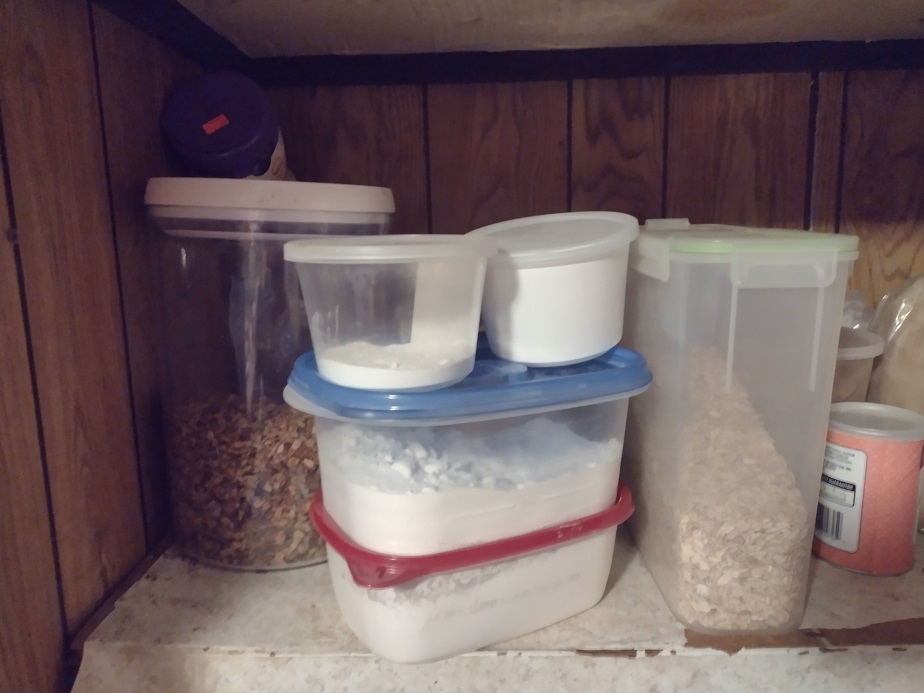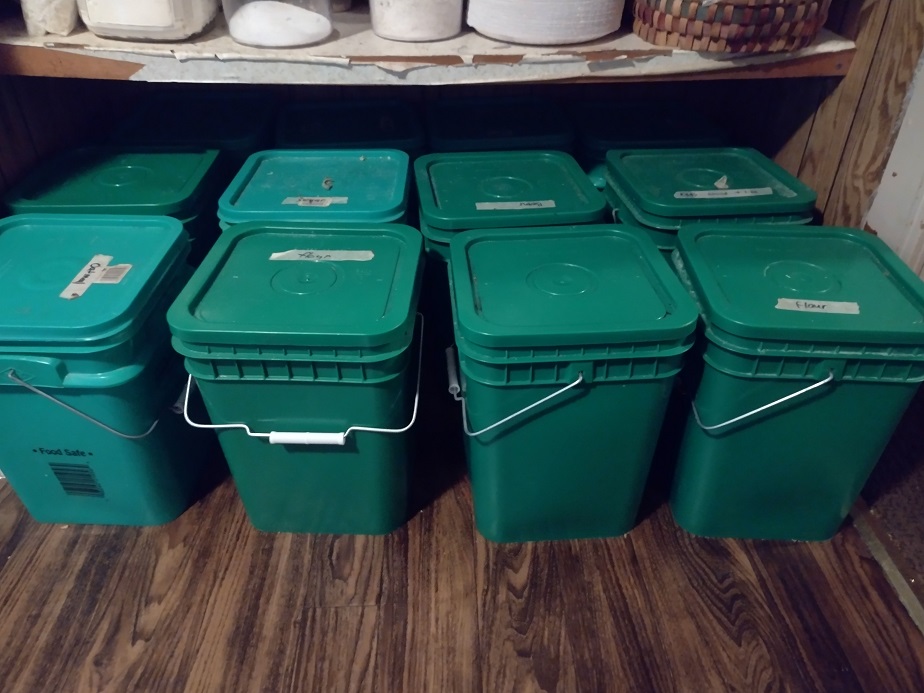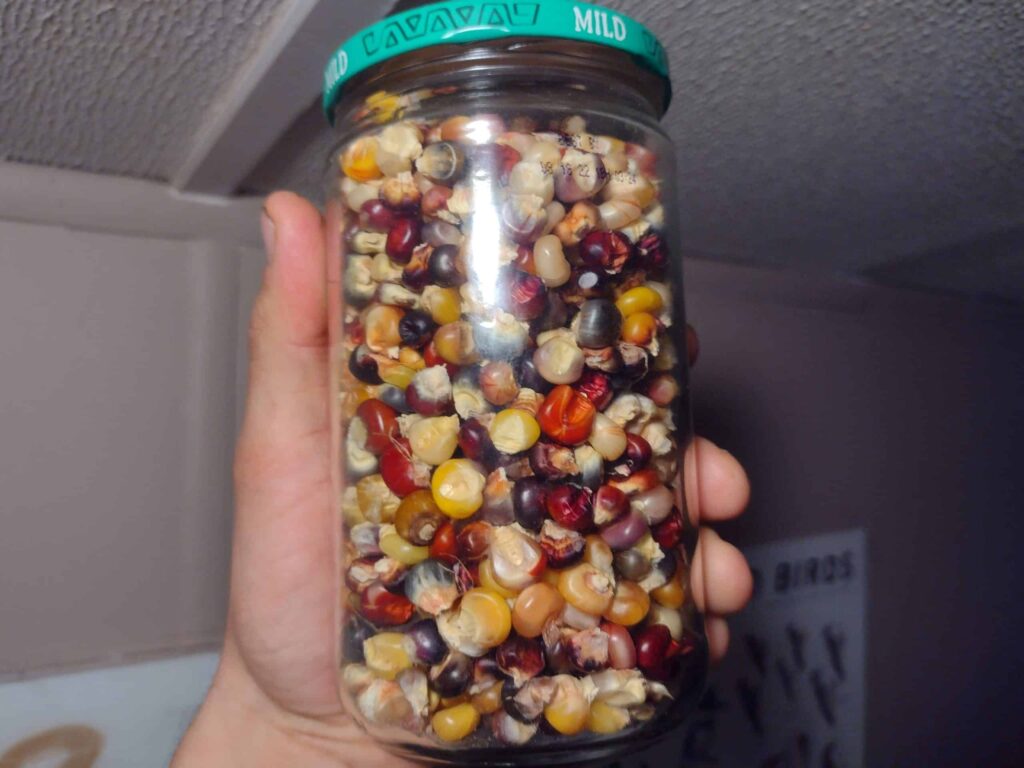We buy 100 pounds of flour every three months or so and keep an extra 100 pounds in the pantry. Storing it is easy.
The best way to store 50 pounds of flour is in two food-grade 5-gallon buckets placed in a pantry or basement. The flour will store best in a cool dry location, and buckets with a rubber seal will help it stay fresh longer. Do not store flour in the sack it comes in, it will likely get full of bugs.
Flour is a great thing to stock up on. But, it also can go bad quickly if not stored well. Here are a few tips for storing flour.
Storing Flour Without it Going Bad
Flour goes bad for two main reasons, bugs, and oxidation. Bugs can and often do get into flour and can make it quite disgusting. Flour also goes rancid. It contains oils, more so in whole wheat flour. Oxegen causes the oil to break down, giving it an off-smell and taste.
That’s what Oxidation does to oil. Rancid doesn’t mean rotten, and it’s certainly still edible, but it will taste old. It won’t make you gag, but it’s not going to make quite the same delicious cookies you’d expect from grandma’s recipe.
To keep it from oxidizing, you need to keep it cool and reduce the amount of oxygen in it. Fill your containers all the way up to limit the amount of oxygen in them. Oxegen absorbers do help. Toss one in on the top of your flour for long-term storage.
Rancid flour isn’t much of an issue really. A lot of people can’t even tell if it’s gone rancid. It does reduce the caloric and nutritional value a little. Moisture can also cause flour to go bad. In most cases, just keeping things dry works fine. But in long-term storage, it’s a little more tricky.
For true long-term storage, use waterproof, airtight containers that flooding and humidity can’t get into. Also, pack it away on a very dry day and fill your containers to the top. Excess air can cause condensation if there are high-temperature swings. Filling buckets on a humid day makes that more likely.

Keeping the Bugs out of Flour
To keep bugs out of flour, it needs to be stored in a tightly sealed plastic or metal container. It doesn’t have to be airtight, just tight. Plastic or tin containers with snap-on lids usually work well. Keep the containers closed up when you’re not using them. Bugs aren’t hard to keep out of flour.
Growing up, my mother always had a well-stocked pantry in the basement. There was always a lot of flour and baking mixes, and moths. The Pantry Moth is a common household pest that would so often get its way into large bags of flour, and even rice. At the time, we didn’t have a good way to keep them out.
I can remember opening up bags of flour to see little worms wriggling in it, the larva of the Pantry Moth. That was the one pest we had get into our flour. Ultimately, things were stored in better sealing containers and moth traps placed around the pantry. It took a few years to get them fully eradicated.
Pantry Moths are small, about half an inch, and light brown in color. Every now and then, I see one in my own home, but we’ve yet to find them in our food. I remember as a kid, placing the moth traps on shelves, and removing ones that were full of the darn little critters.
The main signs of pantry moths are seeing small moths flying around and seeing little webs or threads of bug silk in flour containers. The larvae spin little silk threads as they burrow and eat. You can buy Pantry Moth traps online at Amazon or Tractor Supply Co.
The other common pantry pest is wevils. There are a lot of different wevils but they all look the same, a tiny beetle with a long, skinny snout. Wevils are chewing insects and will chew through any natural material, but they seem to hate chewing through thick plastic.
We never really had wevils growing up. If you see weevils in your cupboard or pantry, you need to act. Toss anything the bugs got into. If you want to try and salvage the food, spread it thinly on a baking sheet and heat it in the oven at 150 for 15-20 minutes. Wiping down surfaces with vinegar helps keep crawling bugs out.
We do that when the ants come in and it helps. Basically, the only way to keep everything out is to use sturdy metal or plastic containers for storage. Flour often sacks allow all these pests to easily crawl into a bug utopia of food. I like to use plastic buckets.

Best Storage Buckets for Flour
The most popular option for storing bulk flour is a food-grade 5-gallon bucket with a screw-on lid. I prefer 4-gallon, square, food-grade buckets because they stack better on a shelf. Square buckets use space more efficiently than round ones.
The buckets I use are pretty cheap, and not air-tight. We currently have about 12 of them full of foodstuff. They don’t have a tight rubber seal under the lid like the more expensive and popular 5-gallon buckets usually do. So, how do I keep bugs out and preserve my food storage?
I’ve yet to see any type of bugs get through the lid even without an airtight seal. The lid is still pretty tight. Also, it’s not a long-term “stow it and forget it” thing we’re doing. Our buckets have ingredients we use regularly, like beans, flour, rice, peanuts, and oatmeal. We use what’s inside and rotate through them.
The idea is to always have more than one bucket full of the same thing. That way, when one gets empty, we re-fill it with fresh foods and start using up the next oldest one.
It’s not hard at all to go through them in this type of rotation if you do a bit of home cooking. Sometimes, by the time we get to finish a bucket of flour, it’s over 6 months old, but it still seems fine.
US Plastics is the company I prefer to do business with because they have good prices, great service, fast delivery, and a high moral standard for business. Their square 4-gallon buckets are all food-grade except for the black ones. They cost about 6 dollars and the lids are another 3 dollars.
Regular 5-gallon buckets with snap-on lids are garbage in my opinion. I have used several different ones from various companies. They are tough to get lids on and off, and lids often crack from all the prying while trying to get them off. That’s why I went with square buckets. square lids pop on and off easily.
I can still seal them if I wanted long-term storage. Some high-quality duct tape like Gorilla Tape or T-rex Tape will give a superb long-term moisture-proof and airtight seal on a cheap bucket.
Here’s a link to the buckets I use. If you want a 5-gallon bucket with a tight sealing lid for true long-term storage, Here’s a link to my favorite airtight 5-gallon bucket.

Storing Flour in Mason Jars
There’s a thing called dry canning. Basically, you put flour (or any other dry foods) in canning jars and use the oven to seal them. It works quite well. To dry can flour, heat it to 180-200 degrees and pt in the flour-filled jars without lids. After an hour, put the lids on finger-tight, and give them another half-hour.
It works just like canning, in that it heats up causing the air to expand over 2x its room-temperature volume. After the lid goes on and the jar is cooled, there is now half or less oxygen in the jar than before. Plus, it has an airtight seal. This also destroys the eggs from any bugs that may have been in the flour.
My wife does it just like this with quart jars. If you used pint jars, the flour may brown in the hour and a half of baking time. Leaving the lid off for the first hour helps the jar to heat up and any excess moisture to bake out. You can fill the jars right up near the top; no need to leave much airspace.
Edit: I need to add this, after a lot of research, I’m not the biggest fan of dry canning. The heating process causes a breakdown of nutrients, particularly oils and thiamine. It works, but a better practice would be a vacuum sealer with a jar sealing attachment.
Can I Just Freeze Flour?
Flour can be frozen and that will help it last. But, if it’s not stored in an airtight container it can start to smell and taste weird after a while. Things in a freezer can sort of absorb smells from other things in there. I call it going freezer-stale. It just makes things undesirable.
Freezing flour may be convenient, but it’s not a long-term storage option for the prepper-minded. If the power goes out, your freezer will be a pool of water and unthawed foods that will rot and mold like crazy. I do use my freezer, but don’t count on it for much food security. It’s a short-term option.
How long Does a 50 Pound Bag of Flour Last?
Flour lasts around 6 months when stored at room temperature in the original package. By 7-8 months, the oils in the flour have oxidized and that will affect the flavor somewhat. If stored in airtight, bugproof containers in a cool location, flour can be stored for years with only a slight difference in flavor.
How Many Gallons Are in 50 Pounds of Flour?
50 pounds of flour is about 10 gallons. 26 pounds of flour will usually fit in a 5-gallon bucket. 100 pounds of flour will fill four 5-gallon buckets or five 4-gallon buckets. Five pounds of wheat flour is about a gallon. A 21-gallon flour bin holds 100 pounds of flour.
There are 200-230 cups of flour in a 50-pound bag, depending on the variety of flour and how much it’s settled. 5 pounds of flour will fit in a large coffee can with a lid. Well, it’s 7 am and all this talk about flour made me want some fresh biscuits. So, I’ll catch ya later, there’s biscuits to bake.
Related articles:

